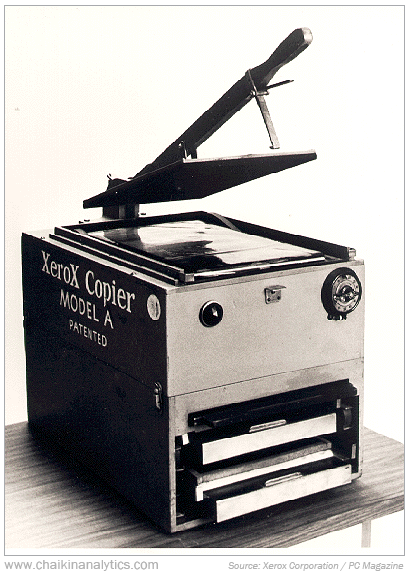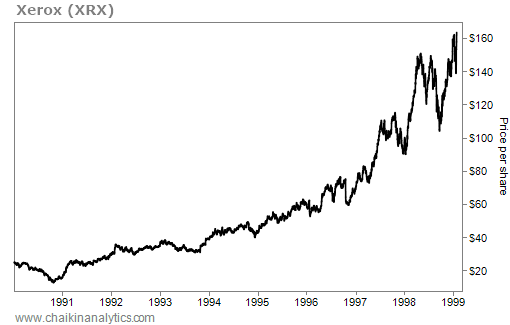Editor's note: Some companies don't just change industries... They redefine the way we live. Today, Pete Carmasino, chief market strategist of our corporate affiliate Chaikin Analytics, explains how some of the most iconic businesses in history have even infiltrated our lexicon. In this issue, adapted from the free Chaikin PowerFeed e-letter, Pete details how small, persistent innovations can transform a company – and its stock – into a household name...
From an early age, Chester Carlson had to work hard to support his family...
While Chester was an infant, his dad, Olaf, got sick with tuberculosis. Olaf also struggled with arthritis of the spine.
And when Chester was 4 years old, his mom, Ellen, contracted malaria. She later died of tuberculosis while Chester was in high school.
To help his parents, Chester worked all sorts of small jobs. As he got older, he'd work for a few hours before going to class... Then he'd go back to work after school.
That's when Chester fell in love with printing...
He loved his rubber stamps and toy typewriter. He made his own newspaper at age 10. And while working for a local printer in high school, he decided to start a science magazine.
But the process was cumbersome. It took far too long to set the type and print an issue.
As Chester recalled in an interview many decades later...
I don't think I printed more than two issues, and they weren't much.
However, this experience did impress me with the difficulty of getting words into hard copy and this, in turn, started me thinking about duplicating processes.
I started a little inventor's notebook, and I would jot down ideas from time to time.
As the years passed, Chester had to work up to three jobs at once to make ends meet.
But whenever he got time, he kept printing...
Chester wanted to figure out how to make fast and cheap prints.
Most prints used a wet-copy process in those days, which took a lot of time and money. And while working at Bell Telephone Laboratories, Chester faced this frustration over and over.
That all changed in October 1938...
Xerox's Run in the 1990s Shows the Power of a 'Verb' Company
Chester finally got his breakthrough while working in his New York City lab...
In short, he made the first "dry" print.
Chester had invented electrophotography. This idea later became known as "xerography" – a combination of the Greek words for "dry" and "writing."
Printing copies became a lot easier and quicker. But no one seemed to care like Chester...
He tried hard to share his new way of printing with the masses. And yet, more than 20 companies declined to fund his operations between 1939 and 1944.
Finally, small photographic-paper maker Haloid decided to take a chance on the idea. The company saw gold in Chester's work. And it wanted a way to upstage rival Eastman Kodak.
Haloid and Chester teamed up to make the first Xerox copy machine in 1949. Take a look...
Xerox (XRX) developed the first automatic copier a decade later. The company's sales skyrocketed. And by the mid-1960s, Xerox owned the printing world.
Xerox got so big that its name became a verb. Many of you probably know what I mean...
When folks wanted to make a copy of something, they would say, "Let me Xerox it."
That doesn't happen often... And it shows how much Xerox ruled the market in that era.
And the company didn't stop there...
It kept pouring cash into its efforts to develop new technologies. It made the first-ever laser printer in 1969. That move kept Xerox on top of the printing world for years.
Xerox's success is a great example of how one innovative idea can change the world...
From his struggles to support his family as a child through all his jobs as an adult, Chester could've quit many times over the years...
But he didn't. And his work made Xerox a giant.
That dominance paid off well for investors. For example, just look at the stock's massive run higher in the 1990s...
Today, we're at the end of Xerox's life cycle. I bet most kids wouldn't even be able to guess what the name means. And the stock isn't anywhere close to its old all-time highs.
But the company is far from alone in making its name a verb. You're surely familiar with these examples...
- To watch a movie or TV show, you "Netflix" it.
- To look up something on the Internet, you "Google" it.
- To buy something without driving to the store, you "Amazon" it.
You don't need me to tell you that Netflix (NFLX), Google parent Alphabet (GOOGL), and Amazon (AMZN) have been some of the best-performing stocks over the past decade-plus.
These companies are household names. And they're the more recent examples of businesses that saw their names become verbs.
The same thing will inevitably happen to other companies, too. So be on the lookout for ones that are already going through this process – or are on the cusp of it.
One of these might just be your next big investing winner.
Good investing,
Pete Carmasino
Editor's note: Chaikin Analytics founder Marc Chaikin just recommended one little-known stock for a company with true "moonshot" potential. It has 95 ironclad patents on a technology that could change the world – and it's on the verge of a major catalyst that could send it 91% higher in two months. But you have to move quickly. Get the full story by clicking here.



